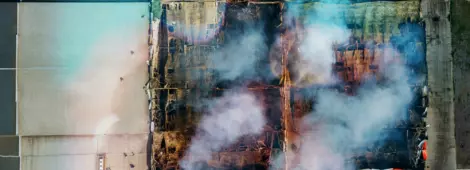
Back Boiler Explosion Risks
by Gareth Williams
Over the years, Jensen Hughes has investigated numerous fires and explosions involving back boilers. While these incidents are becoming less common, they unfortunately still occur, occasionally resulting in serious injuries or death to occupants of properties containing these boilers. It’s important to be aware of the fire and explosion risks associated with back boilers when they are redundant and/or incorrectly decommissioned.
What is a Back Boiler?
A back boiler is a type of boiler typically installed in a fireplace behind either a gas or solid fuel fire. It is designed to provide hot water and central heating to properties, with the water in the back boiler heated by a gas fire or open solid fuel fire (i.e., hot flue gasses and/or radiated heat from coals).
Back boilers consist essentially of a metal water jacket/chamber with a cold-water feed and heated water outlet. The water pipe connection system to the back boiler is typically gravity fed to a hot water cylinder. Pumps can be utilised in the system depending on the requirements for central heating.
Back boilers were commonly installed in properties in the UK and Ireland from the 1960s to 1980s. Since then, due to the emergence of more energy efficient condensing and combi boilers, the manufacture of these boilers declined markedly. In 2005, building regulations in the UK prohibited the installation of these non-condensing types of boilers. Consequently, fewer plumbers and heating engineers carry out repairs on back boilers, with spare parts becoming more difficult to obtain.
Explosion Risks
Fires and explosions associated with back boilers have typically involved one of these common elements:
- A fire lit in the fireplace for the first time in many months or years.
- Conversion of a property’s heating system, with the back boiler decommissioned.
- The draining of a back boiler on a vacant premise, which was subsequently inhabited.
- A change of property ownership/tenancy where the new householders were not aware of the presence of a back boiler.
Depending on the nature of the fire lit in the fireplace, a fire may also have resulted, for example, from the ejection of hot coals.
In 2008, the Health and Safety Executive (HSE) issued a safety alert to raise awareness of the dangers associated with lighting a solid fuel fire when a redundant back boiler has been left in a fireplace. To eliminate the risk of an explosion occurring, a redundant back boiler should be removed completely. If that is not possible, then the associated pipework should be removed.
It is crucial to ensure a redundant back boiler is left in a vented or open condition. If the boiler is left in a sealed condition and a fire is lit in the fireplace, the pressure can build up inside the boiler from the conversion of residual water to steam, even after the water has been drained.
Contractors involved in decommissioning or conversion work can greatly minimise the risk of explosion by simply drilling a few small holes into the body of a redundant back boiler. Sadly, Jensen Hughes has investigated cases where this act has been omitted, resulting in householders sustaining significant injuries.
The Investigation of Back Boiler Explosions
Back boiler explosion investigations require the same methodology as other fire and explosion investigations, including use of the scientific method, comprehensive scene recording, witness interviews, physical evidence inspection and consideration for multiple potential causes. The presence of a gas fire in front of the back boiler will require an inspection of the gas supply to determine whether the explosion occurred due to the ignition of a fuel/air mixture.
A detailed inspection of the back boiler is required to determine whether it is damaged (e.g., distorted, cracked, fragmented) and if there is evidence that the back boiler was left in a sealed condition prior to the explosion. The inspection of the back boiler may require its careful removal from the attached masonry and pipework with the assistance of specialist contractors.
Despite the decreasing frequency of back boiler explosions, Jensen Hughes considers that there will be more of these incidents, as many back boilers are still present in properties throughout the UK and Ireland.

Gareth is a Senior Investigator with experience in fire and explosion investigations in many different settings. Throughout his career, he has investigated over 500 fires in the UK, Europe, Australia, the Pacific and South East Asia. These…












